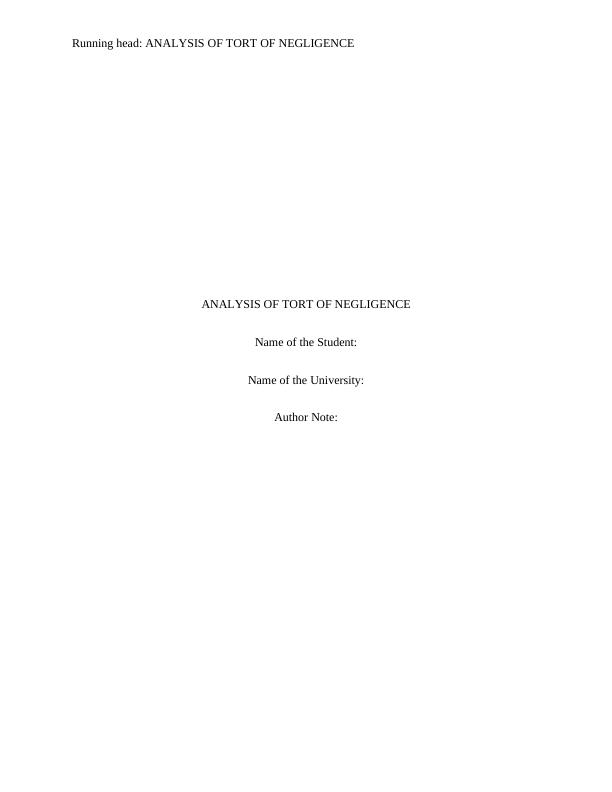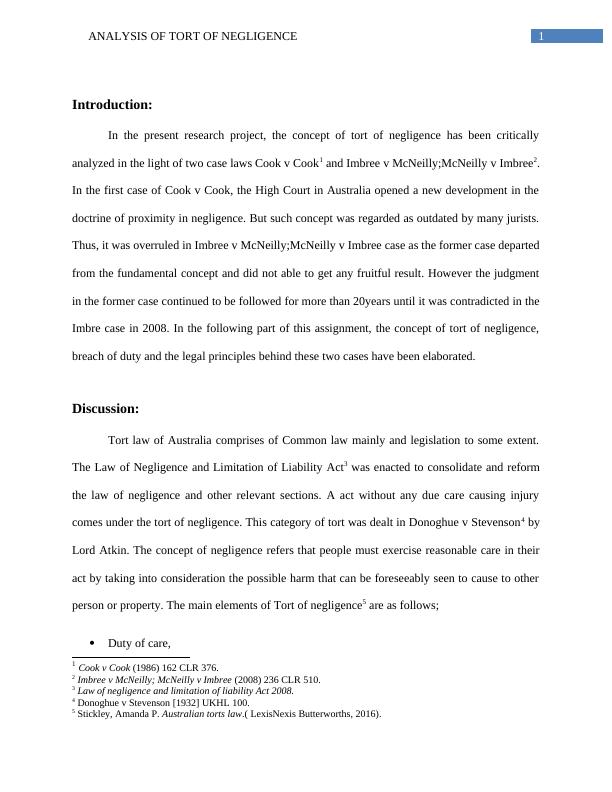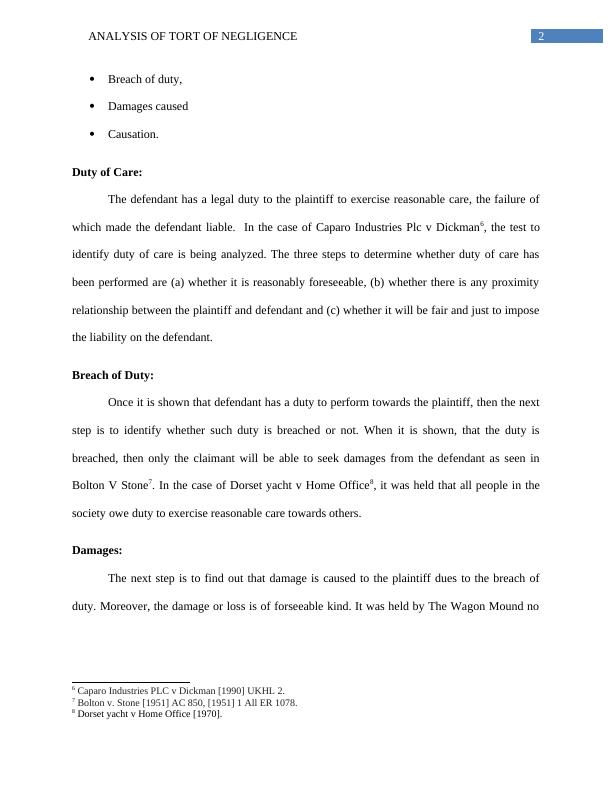Analysis of Tort of Negligence
Added on 2023-04-06
9 Pages2340 Words407 Views
Running head: ANALYSIS OF TORT OF NEGLIGENCE
ANALYSIS OF TORT OF NEGLIGENCE
Name of the Student:
Name of the University:
Author Note:
ANALYSIS OF TORT OF NEGLIGENCE
Name of the Student:
Name of the University:
Author Note:

1ANALYSIS OF TORT OF NEGLIGENCE
Introduction:
In the present research project, the concept of tort of negligence has been critically
analyzed in the light of two case laws Cook v Cook1 and Imbree v McNeilly;McNeilly v Imbree2.
In the first case of Cook v Cook, the High Court in Australia opened a new development in the
doctrine of proximity in negligence. But such concept was regarded as outdated by many jurists.
Thus, it was overruled in Imbree v McNeilly;McNeilly v Imbree case as the former case departed
from the fundamental concept and did not able to get any fruitful result. However the judgment
in the former case continued to be followed for more than 20years until it was contradicted in the
Imbre case in 2008. In the following part of this assignment, the concept of tort of negligence,
breach of duty and the legal principles behind these two cases have been elaborated.
Discussion:
Tort law of Australia comprises of Common law mainly and legislation to some extent.
The Law of Negligence and Limitation of Liability Act3 was enacted to consolidate and reform
the law of negligence and other relevant sections. A act without any due care causing injury
comes under the tort of negligence. This category of tort was dealt in Donoghue v Stevenson4 by
Lord Atkin. The concept of negligence refers that people must exercise reasonable care in their
act by taking into consideration the possible harm that can be foreseeably seen to cause to other
person or property. The main elements of Tort of negligence5 are as follows;
Duty of care,
1 Cook v Cook (1986) 162 CLR 376.
2 Imbree v McNeilly; McNeilly v Imbree (2008) 236 CLR 510.
3 Law of negligence and limitation of liability Act 2008.
4 Donoghue v Stevenson [1932] UKHL 100.
5 Stickley, Amanda P. Australian torts law.( LexisNexis Butterworths, 2016).
Introduction:
In the present research project, the concept of tort of negligence has been critically
analyzed in the light of two case laws Cook v Cook1 and Imbree v McNeilly;McNeilly v Imbree2.
In the first case of Cook v Cook, the High Court in Australia opened a new development in the
doctrine of proximity in negligence. But such concept was regarded as outdated by many jurists.
Thus, it was overruled in Imbree v McNeilly;McNeilly v Imbree case as the former case departed
from the fundamental concept and did not able to get any fruitful result. However the judgment
in the former case continued to be followed for more than 20years until it was contradicted in the
Imbre case in 2008. In the following part of this assignment, the concept of tort of negligence,
breach of duty and the legal principles behind these two cases have been elaborated.
Discussion:
Tort law of Australia comprises of Common law mainly and legislation to some extent.
The Law of Negligence and Limitation of Liability Act3 was enacted to consolidate and reform
the law of negligence and other relevant sections. A act without any due care causing injury
comes under the tort of negligence. This category of tort was dealt in Donoghue v Stevenson4 by
Lord Atkin. The concept of negligence refers that people must exercise reasonable care in their
act by taking into consideration the possible harm that can be foreseeably seen to cause to other
person or property. The main elements of Tort of negligence5 are as follows;
Duty of care,
1 Cook v Cook (1986) 162 CLR 376.
2 Imbree v McNeilly; McNeilly v Imbree (2008) 236 CLR 510.
3 Law of negligence and limitation of liability Act 2008.
4 Donoghue v Stevenson [1932] UKHL 100.
5 Stickley, Amanda P. Australian torts law.( LexisNexis Butterworths, 2016).

2ANALYSIS OF TORT OF NEGLIGENCE
Breach of duty,
Damages caused
Causation.
Duty of Care:
The defendant has a legal duty to the plaintiff to exercise reasonable care, the failure of
which made the defendant liable. In the case of Caparo Industries Plc v Dickman6, the test to
identify duty of care is being analyzed. The three steps to determine whether duty of care has
been performed are (a) whether it is reasonably foreseeable, (b) whether there is any proximity
relationship between the plaintiff and defendant and (c) whether it will be fair and just to impose
the liability on the defendant.
Breach of Duty:
Once it is shown that defendant has a duty to perform towards the plaintiff, then the next
step is to identify whether such duty is breached or not. When it is shown, that the duty is
breached, then only the claimant will be able to seek damages from the defendant as seen in
Bolton V Stone7. In the case of Dorset yacht v Home Office8, it was held that all people in the
society owe duty to exercise reasonable care towards others.
Damages:
The next step is to find out that damage is caused to the plaintiff dues to the breach of
duty. Moreover, the damage or loss is of forseeable kind. It was held by The Wagon Mound no
6 Caparo Industries PLC v Dickman [1990] UKHL 2.
7 Bolton v. Stone [1951] AC 850, [1951] 1 All ER 1078.
8 Dorset yacht v Home Office [1970].
Breach of duty,
Damages caused
Causation.
Duty of Care:
The defendant has a legal duty to the plaintiff to exercise reasonable care, the failure of
which made the defendant liable. In the case of Caparo Industries Plc v Dickman6, the test to
identify duty of care is being analyzed. The three steps to determine whether duty of care has
been performed are (a) whether it is reasonably foreseeable, (b) whether there is any proximity
relationship between the plaintiff and defendant and (c) whether it will be fair and just to impose
the liability on the defendant.
Breach of Duty:
Once it is shown that defendant has a duty to perform towards the plaintiff, then the next
step is to identify whether such duty is breached or not. When it is shown, that the duty is
breached, then only the claimant will be able to seek damages from the defendant as seen in
Bolton V Stone7. In the case of Dorset yacht v Home Office8, it was held that all people in the
society owe duty to exercise reasonable care towards others.
Damages:
The next step is to find out that damage is caused to the plaintiff dues to the breach of
duty. Moreover, the damage or loss is of forseeable kind. It was held by The Wagon Mound no
6 Caparo Industries PLC v Dickman [1990] UKHL 2.
7 Bolton v. Stone [1951] AC 850, [1951] 1 All ER 1078.
8 Dorset yacht v Home Office [1970].

End of preview
Want to access all the pages? Upload your documents or become a member.
Related Documents
Law Assignment: Tort of Negligencelg...
|9
|1722
|538
Commercial Law Case Studylg...
|12
|2873
|232
ARBE1301- Construction Law and Legislationlg...
|14
|3370
|124
Business Law Assignment - Deskliblg...
|9
|2223
|121
Case Study Analysislg...
|7
|1723
|270
Business Lawlg...
|11
|2527
|238